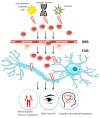The Interaction between Viral and Environmental Risk Factors in the Pathogenesis of Multiple Sclerosis
- PMID: 30646507
- PMCID: PMC6359439
- DOI: 10.3390/ijms20020303
The Interaction between Viral and Environmental Risk Factors in the Pathogenesis of Multiple Sclerosis
Abstract
Multiple sclerosis (MS) is a chronic debilitating inflammatory disease of unknown ethology targeting the central nervous system (CNS). MS has a polysymptomatic onset and is usually first diagnosed between the ages of 20⁻40 years. The pathology of the disease is characterized by immune mediated demyelination in the CNS. Although there is no clinical finding unique to MS, characteristic symptoms include sensory symptoms visual and motor impairment. No definitive trigger for the development of MS has been identified but large-scale population studies have described several epidemiological risk factors for the disease. This list is a confusing one including latitude, vitamin D (vitD) levels, genetics, infection with Epstein Barr Virus (EBV) and endogenous retrovirus (ERV) reactivation. This review will look at the evidence for each of these and the potential links between these disparate risk factors and the known molecular disease pathogenesis to describe potential hypotheses for the triggering of MS pathology.
Keywords: Epstein Barr Virus (EBV); HERV; central nervous system (CNS); cytotoxic T lymphocytes (CTL); multiple sclerosis.
Conflict of interest statement
The authors declare no conflict of interest
Figures




References
-
- Calabrese M., De Stefano N., Atzori M., Bernardi V., Mattisi I., Barachino L., Morra A., Rinaldi L., Romualdi C., Perini P., et al. Detection of cortical inflammatory lesions by double inversion recovery magnetic resonance imaging in patients with multiple sclerosis. Arch. Neurol. 2007;64:1416–1422. doi: 10.1001/archneur.64.10.1416. - DOI - PubMed
Publication types
MeSH terms
Substances
Grants and funding
LinkOut - more resources
Full Text Sources
Medical

